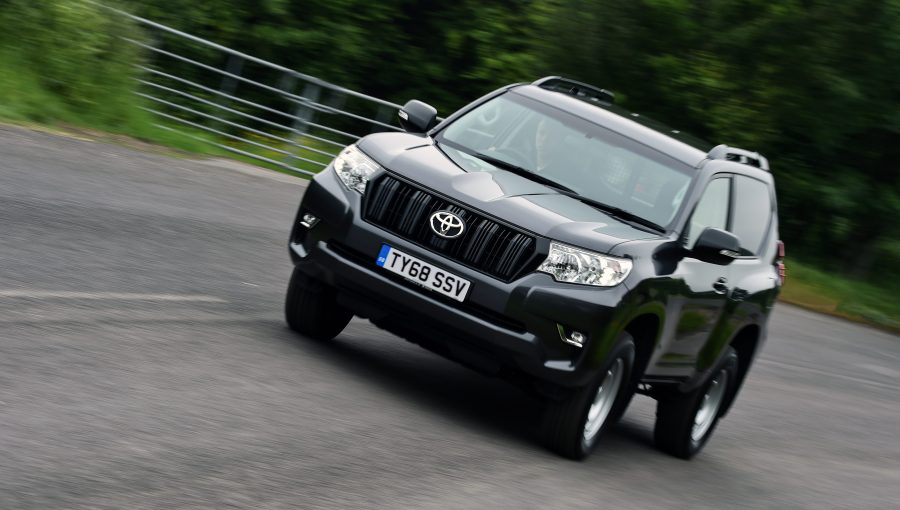Although Toyota’s passenger car range is predominantly focused around petrol-electric hybrid powertrains, the Land Cruiser, Hilux and Proace models are fitted with diesel engines. A diesel particulate filter (DPF) is a feature of these models, and you may have heard about the need for regular DPF regeneration. What does this component do and how do you take care of it?
What does a diesel particulate filter (DPF) do?
The DPF is fitted within the exhaust system and is designed to catch soot particles and nitrous oxide (NOx) from the combustion process that would otherwise be released into the atmosphere. The DPF is highly effective and traps around 80% of these harmful particulates.

Why do modern diesel engines need a DPF?
European legislation places strict exhaust emissions targets on all vehicle manufacturers. From September 2009, the Euro 5 legislative standard came into effect, part of which required all diesel cars registered from that point on to be equipped with a diesel particulate filter, or DPF.
These filters are used throughout the industry in all diesel-powered passenger vehicles, and their efficiency is vital now that stringent Euro 6d emissions standards are in force.
Do I need to replace a DPF during normal servicing?
Diesel particulate filters do have a capacity limit and can become full. But unlike traditional air, oil or pollen filters that need to be exchanged manually at regular intervals, the DPF has a much longer service life and is designed to regenerate to restore its performance.
The car’s electronic control unit (ECU) is programmed to do this automatically, neutralising the soot by burning it off at high temperature within the exhaust system while the vehicle is running. All modern cars with diesel engines follow this procedure.

How does DPF regeneration occur?
The regeneration occurs automatically, usually without the driver being aware that it is taking place. In the majority of cases, the process is carried out when the engine and exhaust system has reached normal operating temperature and the vehicle is travelling at over 40mph.
However, if your driving is limited to urban areas, the low speeds and frequent stops mean the conditions for normal regeneration do not exist. In these instances, the ECU monitors the accumulation of soot and instructs an alternative regeneration programme to begin well before the filter becomes saturated.
This programme injects small quantities of fuel into the engine after combustion, which increases the temperature within the exhaust system and creates an environment where it is possible to safely burn off the soot.
This method is very successful within the small percentage of vehicles where normal regeneration is not possible. However, due to the nature of city traffic, the regeneration process can be interrupted when the vehicle completes its short journey and is turned off. If this occurs, the ECU is programmed to recommence the process when the engine is restarted and back up to temperature again.

How can I help prevent DPF blockages in my Toyota?
Follow these four simple actions:
1. Regularly drive your Toyota on highways at speeds of between 40-55mph for around 20-30 minutes.
2. Avoid spending unnecessary amounts of time with the engine idling.
3, Try to limit the frequency of short journeys where the engine is running for less than ten minutes.
4. Do not ignore dashboard alerts related to the DPF.
Will I be warned if all DPF regeneration processes have been unsuccessful?
Very occasionally, use of the vehicle might be such that it will have been impossible for the ECU to complete the administration of any regeneration procedure. At this point, the DPF will have become overloaded and stopped functioning, so your Toyota will illuminate a warning light in the dashboard. It will then be necessary for the soot to be neutralised and the filter regenerated manually at a main dealer.
It is extremely unwise to ignore this visual warning as the DPF can become irreparably damaged. What’s more, it is illegal to remove the filter entirely.
Learn more: What is the exhaust gas recirculation valve and what does it do?





Hi
Is Toyota warranty coverage the dpf replacement???
Hi John,
Unfortunately, we are unable to comment on Warranty regarding DPF. You would have to speak with your local Toyota Centre or our customer service team for more information and insight. Many thanks.
Hi
I am trying to buy some top-up oil in preparation for a long journey. The oil vendors want to know if my 2010 D4D Yaris has a DPF or not, because this dictates the oil I should buy. Is there a way I can find out whether my vehicle has a DPF or not, e.g. by entering a VIN somewhere that would respond with yes/no for DPF fitted?
Thanks
Roger
Hi Roger,
We should be able to check this for you. In order to attempt this, would you be able to provide us with your VIN/registration number? Many thanks in advance.
Hi
Thanks for your prompt response.
The VIN is **************.
Regards
Roger
Hi Roger,
Our technical team have advised us that your vehicle does have a DPF. 🙂
Hi Roger,
No problem at all. We’ve dropped your VIN with our technical team and they will let us know. Many thanks for your patience.
Hi
I’m just wondering, should Toyota dealers be advising buyers on whether a diesel car with a dpf is suitable for them if they are told of a customers driving habits? Thanks
Hi Mathew,
Regardless of DPF, the dealers should be advising a vehicle which best suits a customer’s driving needs/habits. We would assume that they will be recommending the correct model for you.
I have to say reading these comments I am very disappointed. I too have problems with the dpf on my vehicle, I have returned to my dealer who has said as the problem has continued I will have to replace the filter – my car is still under warranty and as the filter is not a serviceable part I would like an explanation as to why it is not covered. The person at the dealership was unhelpful and down right rude and customer services have not responded. It looks like on here the only answer you can give is ‘go to the main dealer’ or ‘contact customer services’ both of which have failed.
Such ineffienciency and avoidance is not what I expect of a large organisation.
Very disappointed
Hi,
Thanks for getting in touch. As it says above, diesel particulate filters do have a capacity limit and can become full. But unlike traditional air, oil or pollen filters that need to be exchanged manually at regular intervals, the DPF has a much longer service life and is designed to be regenerated to restore its performance. The car’s electronic control unit (ECU) is programmed to do this automatically, neutralising the soot by burning it off at high temperature within the exhaust system while the vehicle is running. All modern cars with diesel engines follow this procedure and have a DPF. Occasionally, use of the vehicle might be such that it will have been impossible for the ECU to complete the administration of any regeneration procedure. At this point, the DPF will have become overloaded and stopped functioning, so the vehicle will illuminate a warning light in the dashboard. It will then be necessary for the soot to be neutralised and the filter regenerated manually at a main dealer.
we do understand your frustration, and if you have a complaint, we’d always recommend contacting our customer relations team. You mentioned that you had already contacted our customer relations team though. Can you provide your case reference number? We can ask that the customer relations team contact you again to clarify our position. Thanks.
I was sold Diesel car without giving relevant information about DPF issues.
Thanks to sales guys at RRG macclesfield, who failed to exercise a reasonable duty of care at a pre-sales level, in order to ascertain whether a Toyota Rav 4 diesel car was suitable for me and my lifestyle, and that they also failed to give me crucial information in relation to the expected use and operation of the vehicle in order to allow me to make an informed choice as to the suitability of a diesel car for my lifestyle / use.
Toyota Diesel car should be avoided .
Hi Monu,
We’re very sorry to hear that you’re unhappy with the service you’ve received. Have you reported this issue to customer relations?
Since we bought our Yaris we’ve had nothing but trouble with the DPF filter. The Toyota Dealership refused to replace the DPF even though the car is only 2 years old and well within warranty. They said that the DPF is a well known problem and they have daily conversations with customers advising them to sell the car when the DPF becomes problematic. Hmm, they didn’t mention this when they sold us the car and I’m pretty sure they’ll fail to mention is to the poor customer that buys our car. One very angry Toyota car owner.
Hi Sarah,
We’re very sorry to hear this. Have you logged your complaint with our Toyota customer relations team? Many thanks.
I had same issue but was insistent the issue was an underlying one. I demanded a resolution and they found a faulty air fuel sensor. Replaced about a year ago under warranty and no issues since
I have a 2007 2.2 diesel Corolla Verso. When I last had my car serviced by a Toyota main dealer i asked if my car had a DPF catalytic converter. The service manager told me that they had no practical sure way of finding out. I did not go to that dealership again and probably never will. I don`t think it has a DPF but I would like to know for sure so that I use the correct engine oil. Can you help. The VIN no. is NMTEA16R80R115195, and the engine no. is 2AD5273459. Also is there any way that a non-mechanic could check just by observation?
Hi Mick,
Our technical department have advised that your vehicle does not have a DPF catalytic converter. For more information on DPF, we would advise contacting customer relations or another Toyota Centre. Have you logged your initial complaint with our customer relations team?
Is it possible , that during the dpf working or just finishing its regeneration , for fumes to enter cabin of car ? Trying to sort out an on going problem with Toyota. They are just not interested at all .
Hi We are having the same problem with a Corolla T180 2008 No windows open, but can smell diesel fumes in the car, surely this is a Health and safety issue too, ironic DPF’s are supposed to be more healthy for us !
Did you resolve the problem with yours ?
Hi Alan,
Thanks for contacting us. The settings of the Heating and Air Conditioning system may have an impact on this. For example, selecting Outside Air or Recirculated Air mode.
However, if you are concerned, we would advise for you to contact your local Toyota Centre.
Thanks.
Doesn’t make any difference and the recirc is working correctly and the diesel smell should not enter the cabin either way. But it does and it comes from my car, it doesn’t have any leaks. I believe that the problem emanates from the DPF system / operation. Time to get an engineer to look at it and possibly pass info onto watchdog as Toyota are very quick to pass the blame away from their shortcomings on the the design, engineering and operation of the DPF system which is now compulsory to pas the MOT if fitted from new but is now where near fit for purpose.
We are sorry to hear that you feel this way. If you believe that there is a technical fault with your vehicle, we would always recommend for you to contact your local Toyota Centre so that they can perform an inspection. If you have any further issues, please feel free to contact our Customer Relations Team. You can find their contact details via the following link:
https://www.toyota.co.uk/contact-us/.
Thanks.
Hi Steve,
Exhaust fumes should not be entering the cabin of the vehicle, this needs to be investigated by a dealer, unless you have the window open and simply smell the fumes stronger when a DPF regeneration is happening. We hope this helps.